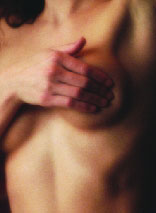Breast self-examination (BSE) is a screening method used in an attempt to detect early breast cancer. The method involves the woman herself looking at and feeling each breast for possible lumps, distortions or swelling.
BSE was once promoted heavily as a means of finding cancer at a more curable stage, but large randomized controlled studies found that it was not effective in preventing death, and actually caused harm through needless biopsies and surgery.
Methods
A variety of methods and patterns are used in breast self-exams. Most methods suggest that the woman stand in front of a mirror with the torso exposed to view. She looks in the mirror for visual signs of dimpling, swelling, or redness on or near the breasts. This is usually repeated in several positions, such as while having hands on the hips, and then again with arms held overhead.
The woman then palpates her breasts with the pads of her fingers to feel for lumps (either superficial or deeper in tissue) or soreness. There are several common patterns, which are designed to ensure complete coverage. The vertical strip pattern involves moving the fingers up and down over the breast. The pie-wedge pattern starts at the nipple and moves outward. The circular pattern involves moving the fingers in concentric circles from the nipple outward. Some guidelines suggest mentally dividing the breast into four quadrants and checking each quadrant separately. The palpation process covers the entire breast, including the "axillary tail" of each breast that extends toward the axilla (armpit). This is usually done once while standing in front of the mirror and again while lying down.
Finally, women that are not breastfeeding gently squeeze each nipple to check for any discharge.
Various mnemonic devices are used as teaching devices. One is called the seven P's of BSE, after seven steps that are named to have the same first initial: Positions, Perimeter, Palpation, Pressure, Pattern, Practice, and Planning what to do if a change is found in the breast tissue.
For pre-menopausal women, most methods suggest that the self-exam be performed at the same stage of the woman's menstrual cycle, because the normal hormone fluctuations can cause changes in the breasts. The most commonly recommended time is just after the end of the period, because the breasts are least likely to be swollen and tender at this time. Women who are postmenopausal or have irregular cycles might do a self-exam once a month regardless of their menstrual cycle.
Limitations
According to a meta-analysis in the Cochrane Collaboration, two large trials found no beneficial effects of screening by breast self-examination "but do suggest increased harm in terms of increased numbers of benign lesions identified and an increased number of biopsies performed." They concluded, "At present, screening by breast self-examination or physical examination cannot be recommended."
Although breast self-examination increases the number of biopsies performed on women, it does not reduce mortality from breast cancer. In a large clinical trial, 132,979 female Chinese factory workers were taught by nurses at their factories to perform monthly breast self-exam, while 133,085 other workers were not taught self-exam. The women taught self-exam tended to detect more breast nodules than those in the control group. The women taught breast self-exam were mostly likely to detect benign or early-stage breast disease. It did not affect mortality.
Because breast self-exam does not save lives, it is no longer routinely recommended by any health authorities for general use. It may be appropriate in selected women. Awareness of breast health and familiarity with one's own body is typically promoted instead of self-exams.
See also
(source:wikipedia)




No comments:
Post a Comment